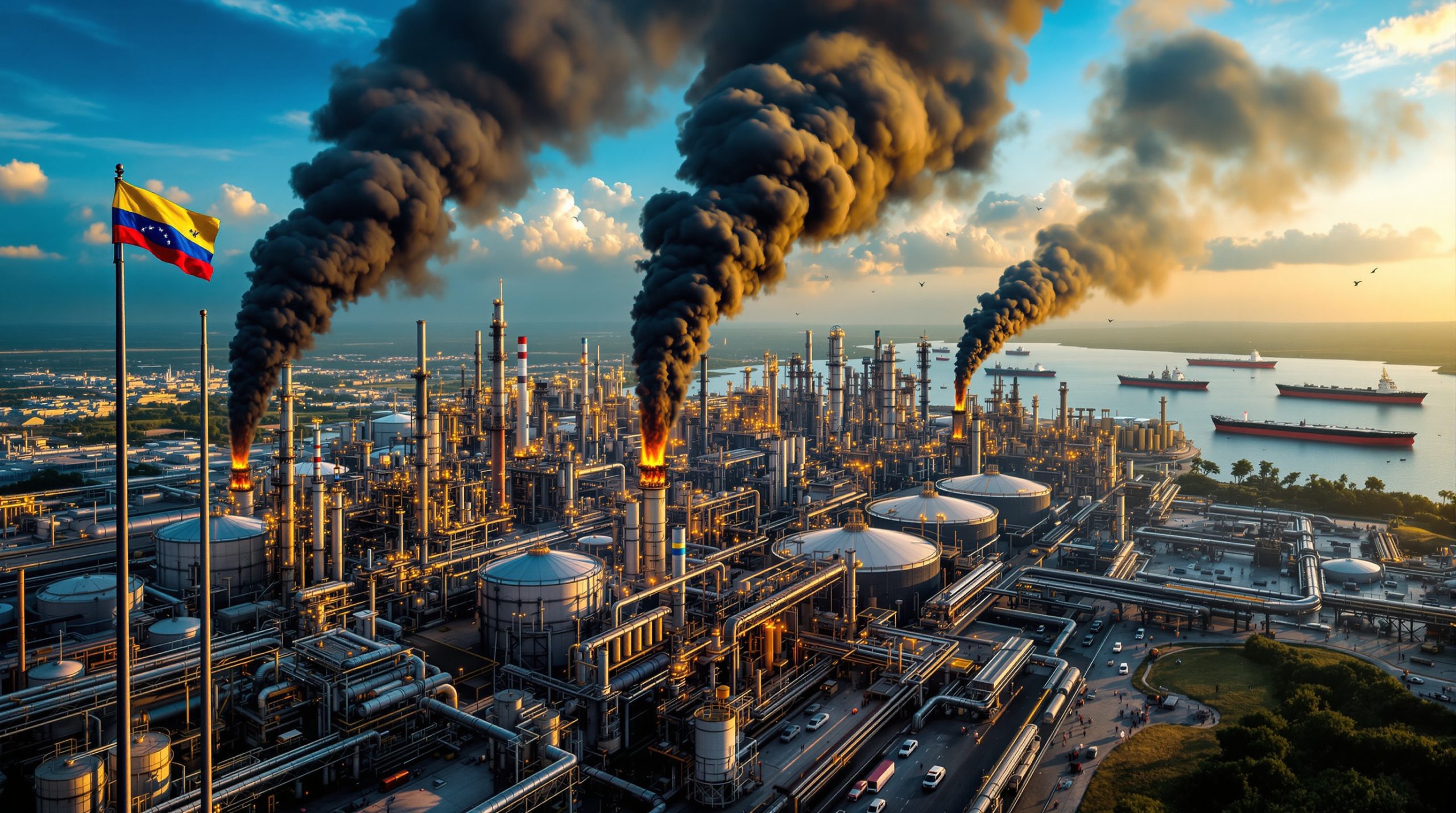Infrastructure Failures Signal Deeper Structural Challenges in Venezuela's Energy Recovery
Global energy markets face mounting uncertainty as aging infrastructure in major oil-producing nations reveals systematic vulnerabilities that extend far beyond individual incidents. The Petrocedeno refinery fire and Venezuela crude exports situation exemplifies how infrastructure degradation intersects with geopolitical tensions, technical failures, and supply chain dependencies to create compounding risks across the global energy system. Understanding these dynamics requires examining not just immediate operational impacts, but the broader structural factors that determine long-term energy security and market stability.
Recent developments in Venezuela's energy sector illustrate how infrastructure vulnerabilities can cascade through global supply chains, affecting pricing mechanisms and strategic planning for both producers and consumers. Furthermore, these incidents highlight the critical importance of volatility hedging strategies in managing exposure to unstable energy markets.
What Does the Petrocedeno Incident Reveal About Venezuela's Energy Infrastructure Vulnerabilities?
Strategic Asset Assessment: Petrocedeno's Role in Venezuela's Export Architecture
The Petrocedeno facility represents a critical node in Venezuela's remaining heavy crude upgrading capacity, with design specifications originally targeting approximately 210,000 barrels per day of extra-heavy crude conversion. This facility processes Orinoco Belt crude with API gravity ranging from 8-12 degrees, transforming it into synthetic crude suitable for international markets.
| Orinoco Belt Upgraders | Design Capacity (bpd) | Operational Status (2024) | Processing Technology |
|---|---|---|---|
| Petrocedeno (PDVSA) | ~210,000 | Limited Operations | Delayed Coking + Hydroprocessing |
| Sincor (Former Shell JV) | ~200,000 | Idled Since 2019 | Delayed Coking + Hydroprocessing |
| Ameriven (Former ConocoPhillips) | ~200,000 | Non-operational | Delayed Coking + Hydroprocessing |
| Mariscal Sucre | ~200,000 | Offline | Delayed Coking + Hydroprocessing |
The technical complexity of heavy crude upgrading creates multiple vulnerability points that extend beyond basic refinery operations. These facilities require consistent natural gas supply for hydrogen generation, stable electrical power for complex control systems, and specialised maintenance expertise that has become increasingly scarce due to international sanctions and workforce emigration.
According to a recent report from Reuters, the fire at the facility has highlighted the precarious state of Venezuela's energy infrastructure.
Infrastructure Resilience Modelling Under Geopolitical Pressure
Venezuela's energy infrastructure has experienced systematic degradation since 2015, with deferred capital expenditures estimated at over $1 billion annually through 2023. This underinvestment cycle compounds operational risks through multiple channels:
- Equipment Aging: Most Orinoco upgraders constructed between 1990-2005 without major refurbishment
- Spare Parts Constraints: International sanctions limiting access to specialised refining components
- Technical Expertise Gaps: Exodus of skilled engineers and technicians during economic crisis
- Power Grid Instability: National electrical system experiencing frequent major disruptions
Historical patterns reveal recurring cycles of facility incidents coinciding with periods of heightened geopolitical tension. In addition, the concentration of remaining operational capacity in fewer facilities magnifies the systemic impact of individual disruptions, creating what analysts term infrastructure brittleness where single points of failure can affect entire export programs.
How Has Venezuela's Crude Export Performance Evolved Throughout 2025?
Export Volume Recovery: Quantifying the Comeback
Venezuela's oil production trajectory shows gradual recovery from historic lows, though recent figures remain well below historical capacity. OPEC production estimates indicate Venezuelan output reached approximately 936,000 bpd in recent months, representing modest gains from previous reporting periods but still reflecting significant constraints compared to the country's 3+ million bpd capacity achieved in previous decades.
| Period | Production (bpd) | Export Volume (bpd) | Primary Destinations |
|---|---|---|---|
| 2012 Peak | ~3,000,000 | ~2,500,000 | United States (Primary) |
| 2019 Sanctions | ~1,300,000 | ~800,000 | China, India, Caribbean |
| 2020 Low Point | ~400,000 | ~300,000 | China (Dominant) |
| 2023 Estimate | ~770,000 | ~650,000 | China (80%+), India, Others |
The recovery pattern reflects both technical constraints and market access limitations. However, export destination diversification has become a strategic necessity, with China emerging as the dominant buyer through oil-backed financing arrangements that provide critical foreign currency access for the Venezuelan government.
Market Diversification Strategy Analysis
China's position as Venezuela's primary crude buyer represents a fundamental shift from historical trade patterns. Prior to 2017, the United States imported approximately 500,000 bpd of Venezuelan crude, making it the country's largest single market. Current arrangements show China accounting for an estimated 85% of Venezuelan crude exports through structured financing mechanisms that combine energy trade with development lending.
Key Market Dynamics:
- Chinese Arrangements: Long-term purchase commitments linked to infrastructure financing
- U.S. Market Re-entry: Limited volumes authorised through Treasury Department licenses
- Indian Refiners: Secondary buyer position with flexible commercial terms
- Caribbean Processing: Regional refinery partnerships for domestic supply
The market concentration creates both opportunities and vulnerabilities for Venezuelan energy planning. Consequently, while Chinese demand provides revenue stability, over-dependence on single buyers limits pricing negotiation capacity and creates potential supply disruption risks if geopolitical relationships shift.
What Are the Geopolitical Implications of Venezuela's Oil Infrastructure Incidents?
U.S.-Venezuela Relations: Strategic Escalation Patterns
The evolution of U.S.-Venezuela relations shows escalating patterns of economic and diplomatic pressure since 2017, with sanctions architecture expanding from targeted financial restrictions to comprehensive sectoral limitations. Understanding current tensions requires examining both historical precedent and contemporary strategic calculations across multiple decision-making frameworks.
Sanctions Escalation Timeline:
- August 2017: Initial PDVSA debt refinancing restrictions
- January 2019: Primary sanctions designation blocking U.S. transactions
- 2020-2022: Expanded restrictions on international partners
- April 2023: Limited licence authorisation for specific operations
Regional strategic considerations extend beyond bilateral Venezuela-U.S. dynamics to encompass broader Caribbean security architecture and hemispheric energy supply chains. Furthermore, global trade tensions have influenced regional dynamics, as the U.S. maintains significant military presence through Southern Command operations, while Venezuela's alignment with China, Russia, and Iran creates competing spheres of influence within traditional U.S. regional hegemony.
Scenario Analysis: Three Potential Outcomes for Venezuela-U.S. Energy Relations
Scenario 1: Gradual Sanctions Relief
- Conditional easing tied to political transition discussions
- Phased restoration of U.S. market access for Venezuelan crude
- International oversight mechanisms for revenue transparency
Scenario 2: Continued Strategic Competition
- Maintained sanctions architecture with periodic adjustments
- Chinese and Indian market dominance consolidation
- Regional proxy competition through energy partnerships
Scenario 3: Direct Confrontation Escalation
- Enhanced coercive measures including potential military options
- Accelerated regional migration and humanitarian implications
- Global energy market volatility from supply disruption fears
"Geopolitical Risk Premium: Venezuelan instability affects global oil markets through risk perception mechanisms that extend beyond the country's actual production contribution, creating pricing volatility that reflects broader geopolitical uncertainty rather than fundamental supply-demand balance."
How Do Infrastructure Fires Affect Heavy Crude Processing and Global Supply Chains?
Technical Impact Assessment: Upgrader Downtime Consequences
Heavy crude upgrading represents one of the most technically complex and capital-intensive processes in global energy production. Venezuelan extra-heavy crude requires sophisticated thermal and catalytic processing to achieve export specifications, involving delayed coking operations at temperatures exceeding 500°C and hydroprocessing systems operating under extreme pressure conditions.
Upgrading Process Critical Parameters:
- Feed Quality: 8-12° API gravity requiring carbon rejection
- Operating Conditions: 400-500°C coking temperatures, 200-400°C hydroprocessing
- Hydrogen Requirements: Consistent natural gas feed for on-site generation
- Utility Dependencies: Stable electrical power, cooling water systems, steam generation
Infrastructure fires at upgrading facilities create cascading operational impacts that extend far beyond immediate production losses. Recovery timelines depend on damage assessment, equipment replacement availability, and technical expertise mobilisation—all factors constrained by current sanctions and supply chain limitations.
| Global Heavy Crude Upgrading Capacity by Region | Total Capacity (bpd) | Primary Feedstock Sources | Market Destinations |
|---|---|---|---|
| North America (Canada) | ~1,800,000 | Athabasca Oil Sands | U.S. Midwest, West Coast |
| South America (Venezuela) | ~800,000 (design) | Orinoco Belt | China, India, Caribbean |
| Middle East | ~600,000 | Various Heavy Crudes | Asia-Pacific |
| Europe | ~300,000 | Import-dependent | European Markets |
Supply Chain Resilience Modelling
Global heavy crude processing capacity shows significant regional concentration, with Canadian and Venezuelan facilities accounting for approximately 60% of total upgrading capacity worldwide. This geographic concentration creates potential bottlenecks that affect pricing differentials between heavy and light crude benchmarks.
Alternative processing scenarios for Venezuelan heavy crude face multiple constraints. Most global refineries lack the specialised equipment required for extra-heavy crude processing, limiting substitution opportunities. Chinese refineries have invested in heavy crude processing capabilities specifically to handle Venezuelan imports, creating structural market dependencies that extend beyond simple commercial relationships.
Market Substitution Challenges:
- Technical Specifications: Limited refineries equipped for 8-12° API crude
- Transportation Costs: Specialised tanker requirements for heavy crude
- Processing Economics: Higher operating costs for heavy vs. light crude
- Product Slate Variations: Different yield patterns affecting downstream markets
What Does This Incident Signal About Venezuela's Energy Sector Recovery Prospects?
Production Capacity Trends and Infrastructure Constraints
Venezuela's energy sector recovery faces fundamental structural challenges that extend beyond immediate operational issues to encompass broader economic and technological constraints. Current production levels reflect not just sanctions impacts but decades of underinvestment in reservoir management, drilling programs, and infrastructure maintenance.
Recovery Constraint Analysis:
- Reservoir Decline: Natural depletion in mature fields without adequate investment
- Drilling Activity: Limited new well development due to equipment restrictions
- Transportation Infrastructure: Port facilities and pipeline system degradation
- Workforce Capacity: Technical expertise gaps from emigration patterns
OPEC production estimates showing Venezuelan output at 936,000 bpd represent modest improvement from historic lows but remain far below the country's demonstrated production capacity. For instance, achieving sustained production growth requires addressing multiple interdependent factors simultaneously, creating complex coordination challenges under current political and economic constraints. Understanding these declining oil production factors provides crucial insight into similar challenges facing the global energy sector.
Economic Recovery Trajectory Assessment
Oil revenue correlation with broader Venezuelan economic performance creates feedback loops that affect energy sector investment capacity. Government revenue dependence on petroleum exports limits fiscal resources available for infrastructure restoration, while economic instability affects workforce retention and technical capability development.
Investment Requirement Estimates:
- Immediate Maintenance: $2-3 billion for critical facility restoration
- Capacity Expansion: $15-20 billion for pre-2019 production levels
- Infrastructure Modernisation: $25+ billion for long-term competitiveness
- Technology Upgrade: Ongoing requirements for digital systems and automation
"Hypothetical Scenario: If Venezuela achieved pre-2019 production levels of 1.3+ million bpd, global heavy crude markets would require significant supply chain adjustments, particularly affecting pricing relationships with Canadian oil sands production and Middle Eastern heavy crude exports."
How Should Energy Markets Price Venezuelan Oil Risk Moving Forward?
Risk Premium Calculation Frameworks
Venezuelan oil risk assessment requires multi-dimensional analysis incorporating geopolitical, operational, and counterparty risk factors. Traditional country risk models must account for unique characteristics of the Venezuelan energy sector, including sanctions compliance requirements, infrastructure vulnerability, and political transition uncertainties.
| Risk Premium Comparison – Venezuelan vs. Other High-Risk Producers | Geopolitical Risk | Infrastructure Risk | Counterparty Risk | Total Premium Estimate |
|---|---|---|---|---|
| Venezuela | Very High | Very High | High | $8-12/barrel |
| Iran | Very High | Medium | High | $6-10/barrel |
| Libya | High | Medium | Very High | $7-11/barrel |
| Nigeria | Medium | High | Medium | $4-8/barrel |
| Iraq | High | Medium | Medium | $5-9/barrel |
Risk premium calculations must incorporate both probability assessment and impact magnitude across multiple time horizons. Venezuelan-specific factors include sanctions compliance costs, political transition scenarios, and infrastructure restoration timelines that create unique valuation challenges for market participants.
Investment Decision Matrix for Venezuelan Energy Exposure
International energy companies evaluating Venezuelan opportunities must navigate complex regulatory, operational, and strategic considerations that extend beyond traditional commercial analysis. Due diligence frameworks require specialised expertise in sanctions law, political risk assessment, and operational security evaluation.
Due Diligence Considerations:
- Regulatory Compliance: OFAC licence requirements and ongoing monitoring
- Operational Security: Personnel safety and asset protection protocols
- Political Risk: Government stability and policy continuity assessment
- Commercial Terms: Currency convertibility and contract enforceability
- Technical Assessment: Infrastructure condition and restoration costs
- Environmental Liability: Historical contamination and remediation requirements
"Investor Alert: Venezuelan energy sector exposure requires specialised risk management approaches that account for rapid policy changes, operational disruptions, and complex international legal frameworks that can significantly affect investment returns and recovery timelines."
What Are the Long-Term Strategic Implications for Global Heavy Crude Markets?
Market Structure Evolution Under Venezuelan Supply Uncertainty
Global heavy crude markets face structural transformation as Venezuelan supply volatility affects traditional trade flows and pricing relationships. Market concentration in alternative heavy crude sources creates potential supply security risks for refiners dependent on specific gravity specifications and processing configurations.
Heavy Crude Market Dynamics:
- Canadian Oil Sands: Stable production but transportation constraints
- Mexican Heavy Crude: Declining production from mature fields
- Middle Eastern Heavy: Limited spare capacity for market expansion
- South American Alternatives: Brazil, Colombia production growth potential
Technology advancement implications for heavy crude processing include emerging extraction techniques, upgrading efficiency improvements, and synthetic crude quality enhancements that may affect long-term market competitive dynamics. These developments create both opportunities and challenges for traditional heavy crude producers facing infrastructure constraints.
Energy Security Policy Responses
Strategic petroleum reserve considerations for heavy crude reflect growing recognition that supply diversification requires maintaining access to various crude specifications rather than focusing exclusively on light, sweet benchmarks. Policy frameworks must account for refining system compatibility and processing capability distribution across different crude types.
International Cooperation Frameworks:
- Bilateral Energy Partnerships: Direct government-to-government arrangements
- Multilateral Reserve Coordination: IEA strategic release mechanisms
- Technology Sharing Agreements: Heavy crude processing advancement
- Infrastructure Investment: Cross-border pipeline and refining capacity
Regional energy security planning must incorporate scenarios where the Petrocedeno refinery fire and Venezuela crude exports remain constrained for extended periods, requiring alternative sourcing strategies and potentially modified refining configurations to maintain product supply reliability. Additionally, monitoring OPEC production impact becomes crucial for understanding global market adjustments.
Navigating Venezuela's Energy Infrastructure Challenges: Strategic Framework for Market Participants
Key Monitoring Indicators for Venezuelan Energy Sector Stability
Market participants require systematic monitoring frameworks that track multiple indicators across political, economic, and operational dimensions. Early warning systems must integrate real-time data on facility operations, export flows, political developments, and international regulatory changes that affect Venezuelan energy sector access.
Primary Monitoring Categories:
- Production Metrics: Monthly output data, facility utilisation rates, export volumes
- Political Indicators: Government stability measures, international negotiations, sanctions modifications
- Infrastructure Status: Facility maintenance schedules, incident reporting, upgrade investments
- Market Access: Buyer diversification, pricing differentials, transportation availability
- Regulatory Environment: Sanctions compliance updates, licence modifications, enforcement actions
However, market participants should also consider broader market trends such as oil price rally insights when developing comprehensive risk assessment strategies.
Risk Management Frameworks for Crude Oil Market Exposure
Venezuelan energy sector volatility requires sophisticated risk management approaches that account for multiple correlation factors and non-linear impact relationships. Portfolio construction must consider not just direct Venezuelan exposure but indirect effects through heavy crude pricing, refining margins, and substitute product availability.
Hedging strategies for Venezuelan oil risk involve complex instrument combinations including political risk insurance, commodity price hedging, and foreign exchange protection. Market participants must evaluate counterparty risk not just in Venezuelan entities but in international partners and financial institutions with Venezuelan exposure.
Policy Implications for Regional Energy Security Planning
Regional energy security frameworks must incorporate Venezuelan supply scenarios across multiple probability distributions, recognising that current uncertainties may persist for extended periods regardless of specific political outcomes. Infrastructure planning requires considering alternative supply sources and processing capabilities that maintain system flexibility under various supply configurations.
Strategic Planning Elements:
- Supply Source Diversification: Reducing dependence on single heavy crude suppliers
- Processing Capability Enhancement: Upgrading refining systems for feedstock flexibility
- Transportation Infrastructure: Developing alternative crude oil delivery systems
- Emergency Response Protocols: Coordinating regional responses to supply disruptions
- Investment Attraction: Creating stable policy frameworks for long-term energy investments
According to Oil Price, the magnitude of the recent facility fire demonstrates the urgent need for enhanced safety protocols and infrastructure modernisation across Venezuela's energy sector.
Long-term energy market evolution will likely incorporate lessons from Venezuelan supply volatility, leading to enhanced resilience mechanisms, improved risk assessment methodologies, and more sophisticated international cooperation frameworks for managing energy security challenges in an increasingly complex geopolitical environment. Consequently, the Petrocedeno refinery fire and Venezuela crude exports situation serves as a critical case study for understanding infrastructure vulnerabilities and their cascading effects on global energy markets.
Ready to Capitalise on Energy Market Volatility?
Discovery Alert's proprietary Discovery IQ model delivers instant notifications on significant ASX mineral discoveries, including energy sector opportunities that emerge from global market disruptions like Venezuela's infrastructure challenges. With real-time alerts covering over 30 commodities, subscribers gain actionable insights to navigate volatile markets and identify discovery-rich announcements before broader market recognition—start your 30-day free trial today to secure your competitive advantage.




